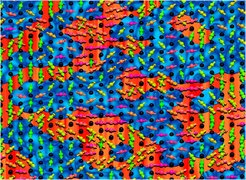Press Release: Nano islands instead of stripes
The origin of the "hour-glass" spectrum
The magnetic hourglass spectrum has fascinated physicists over many years. This phenomenon has been observed in copper oxides, a class of materials with highest superconducting transition temperatures known to mankind. Many physicists expect that magnetic excitations are the key to the understanding of high-temperature superconductivity. Scientists around Alexander Komarek studied a cobalt oxide material that surprisingly also exhibits such an hourglass spectrum. Since these compounds are insulators, the number of possible mechanisms of hourglass spectra is reduced in these materials. Additionally to neutron scattering the scientists used X-ray diffraction. The neutrons gave insight in the magnetic properties of the material. The X-rays revealed the charge distribution within the cobalt oxide crystal. An extremely fine X-ray beam was used at the synchrotron PETRA-III at DESY such that the charge distribution could be determined on the nano scale (10-6 mm).
The outcome of these experiments was rather surprising. "The crystal consists of layers where a stripe-like arrangement of charges has been expected." says Alexander Komarek. "Instead, we observed a microscopic structure of charge-depleted and charge-rich regions.? The diameter of these charge-free and -rich islands amounts to roughly 1 nm in average. Alexander Komarek calls this phenomenon a novel kind of nano phase separation, where two phases emerge on the nano scale, which are electronically and magnetically strongly decoupled.
As a consequence, the energy-rich (upper) part of the hourglass spectrum arises from the excitations within the charge-free islands and the low-energy excitations are mainly hosted within the charge-rich islands. This is in contrast to previous models that assumed a single dispersion arising from the entire material as a whole.
The strongly different size of exchange interactions between the magnetic ions in both different nanoscopic regions serves as an explanation for this effect. Because the exchange interactions are much stronger within the charge-free islands, the magnetic excitations exceed to higher energies. A simplified mechanical analogy would be a chain of balls that are coupled either with strong or with weak springs. The high-frequency oscillations of regions coupled with strong springs are strongly decoupled from the low-frequency oscillations of the regions coupled with weak springs. In analogy the magnetic spectrum can be subdivided in two different parts of excitations. Additionally, the scientists observed an additional high-energy magnetic excitation at very high energies using neutron spectroscopy (ILL, FRM II, LLB). This additional excitation was never observed before but should be present according to the new nano phase separation model.
AK / CPfS

Nanoscopic charge distribution: Max-Planck scientists observe two distinct regions on the nano scale in a cobalt oxide crystal - charge-poor (red) and charge-rich (blue) regions. Additionally, the magnetic properties of this material were studied. The arrows provide the direction of the electron spin or of the magnetic moment of each single cobalt atom.
